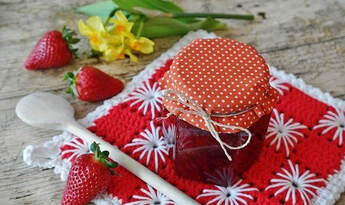
Freezer jam is my favorite as it is not really cooked, so you get that full, fresh, strawberry flavor. However, it does take up room in the freezer, and of course you have to wait for it to thaw before eating, so I do like to can most of our strawberry jam.
However, I discovered several years ago that I really don't care much for canned jams that contain pectin - especially strawberry. Pectin seems to change the color and flavor to make it much less appealing. Plus, you have to use more sugar than fruit to get it to gel properly, which makes no sense to me. I want to taste the strawberries - not a mouthful of sugar!
Since I started making the old-fashioned kind of jam without pectin, I have re-discovered my love for strawberry jam. Not only does it taste better, but it's a lot healthier for you as it uses less than half as much sugar! I actually haven't used pectin for years now in any kind of jam. I have found that just about any kind of fruit will gel up nicely if you cook it long enough.
Below is an excellent recipe for homemade low-sugar strawberry jam without pectin. If you're not feeling up for canning (which is easier than you may think - especially for jams), you can certainly also refrigerate this jam for up to 6 weeks, or freeze it for longer-term storage.
Low-Sugar Strawberry Jam Recipe without Pectin*
Yield: 8 half-pints
Total Time: About 1 hour
Ingredients:
- 8 cups strawberries (rinsed and hulled, before mashing)
- 3 cups sugar
- Zest from 2 lemons
- ¼ cup lemon juice
Instructions:
- Wash jars and bands in hot soapy water. Rinse well.
- Fill water bath canner with water and put on medium heat. Put empty jars into the canner and bring to a boil. Let boil for 15 minutes, then carefully remove using a jar lifter and allow to cool on a clean kitchen towel.
- Meanwhile, mash berries with a potato masher, blender, or immersion blender to desired consistency. I prefer mine chunky. (Note that liquid or pureed berries take longer to reach the gelling point)
- Place berries, sugar, lemon juice, and lemon zest into a large pot. Stir until well combined. Bring berries to a boil. Stir frequently to keep sugar from scorching.
- Simmer on a low boil for 20 minutes.
- Test your jam's thickness using one of the two methods below.
- Once your jam is at the right thickness, it's time to pull it off the heat. Place the pot on a heat-proof trivet and let sit about 5 minutes, stirring occasionally.
- Place clean jars on a dish towel. Fill jars with a ¼ inch from the top with jam. A canning funnel will be your best friend during this part. With a clean damp towel, wipe down rim of jar. Place lids on, then bands, and screw down to finger tight.
- Immerse jars in water bath canner inside the canning rack, making sure water covers the tops of the jars by 1 to 2 inches. Once water is boiling, set timer for 10 minutes and allow jars to process.
- When time is up, turn off heat. Wait 5 minutes and then remove jars from canner. Place on a folded kitchen towel in a draft free area. Allow to cool and set overnight or for at least 12 hours.
- Check seals. If the center of the lid gives, then store in the fridge and eat soon.
- If jars are sealed, wipe down with a damp cloth and store in the pantry out of the light for up to a year. Always inspect your jars of jam and jelly before using. If the seal is broken, the jar is leaking, off odor, off appearance, or any signs of mold, do not eat or taste it. Throw it out. Check the seal when you go to use a jar, even if it sealed when you put it in the pantry. Seals can sometimes come undone over time.
Gel Test Methods
There are several different ways to check the thickness of your jam for gelling. Some prefer the sheeting or spoon test, but I prefer the saucer test instead. Take your pick and see which works better for you:
1. The Sheeting Test or Spoon Test
You can test the set of the jam by the sheeting test. Place a metal spoon in the freezer when you begin making your jam. After the 20 minutes of boiling, dip the chilled spoon into the jam quickly and remove it. Hold the spoon and watch the way the jam drips off of the spoon. If it's little individual drops, the jam is not set, if it’s big goops, it’s almost there. If it comes off the spoon in a sheet or doesn’t really drop off at all, then jam is set, yank that baby off the heat.
2. The Saucer Test
Place a saucer in the freezer when you begin making your jam. When you're ready to test it, pull out the saucer and put a few drops (about 1/2 teaspoon) of jam on the saucer. Let it sit for a couple of minutes, then tip the saucer and hold it vertically. If the jam runs, it needs to cook longer. If it stays in place or only moves slightly, draw a finger through the jam. If it doesn't run back in place to fill your finger mark, it's done.
Keep in mind that since you're not using pectin, this is not an exact science. Your cook time may vary depending on the ripeness and juiciness of your berries, as well as how much you have pureed them. If you check your jam in Step 6 using the sheeting test and it is not gelling yet, just keep cooking it longer, stirring frequently, until it passes the test. Also be aware that your jam will thicken as it cools. If it seems jam-like while it's cooking, it may actually be TOO thick when it cools. (I had a batch of blackberry jam that I cooked down so far that it was almost chewy when it cooled! It was still delicious, but way too thick.)
Strawberry season is starting, so keep an eye out for sales, and get ready to make some delicious jam! :-)
Rose.
* Recipe Source: MelissaKNorris.com



 RSS Feed
RSS Feed